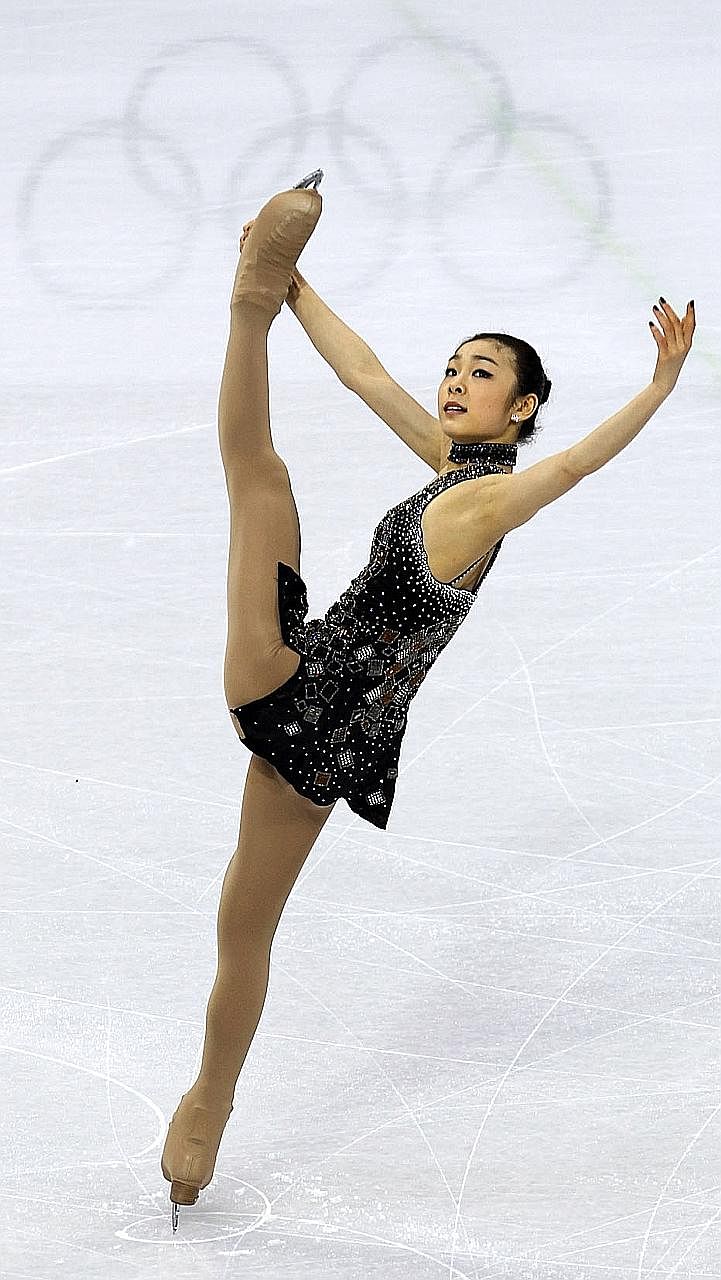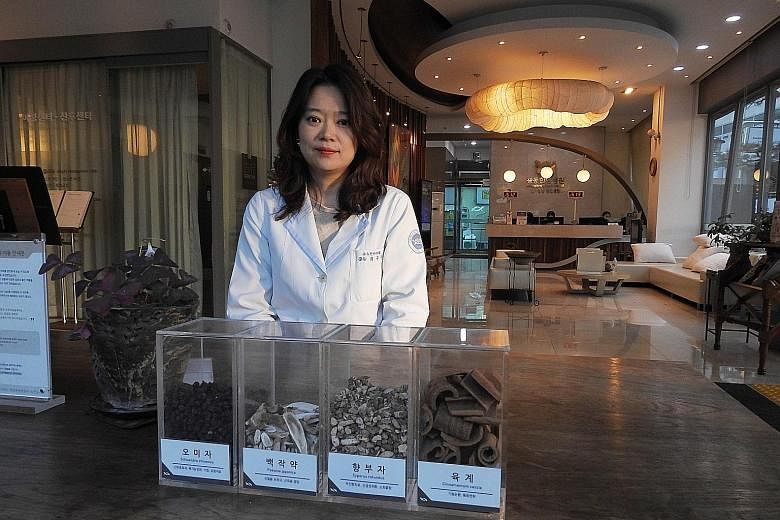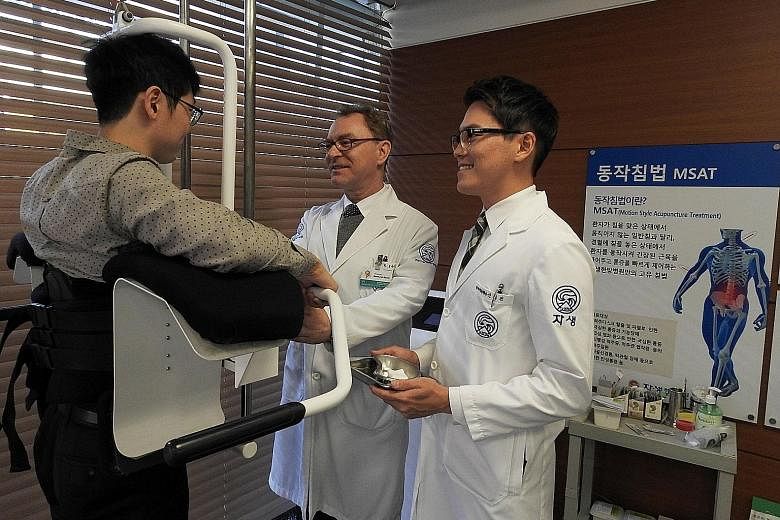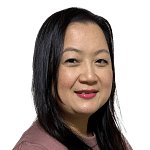In the days when South Korea's celebrated Olympic figure skater Kim Yuna ruled the rinks, she had a secret weapon up her boots - acupuncture.
The world's undisputed figure-skating queen before she retired in 2014, she relied on the therapy, an integral part of traditional Korean medicine or hanbang, to alleviate the back pain she suffered during her demanding career.
Her compatriot, football star Park Ji Sung, likewise turned to hanbang whenever his leg was injured, and even to review his health.
Korean sports teams also often hire hanuisa (traditional Korean physicians) to treat athletes who get hurt during training.
The use of hanbang by the elite sportsmen reflects the enduring popularity of the Korean offshoot of traditional Chinese medicine (TCM). Hanbang is also increasingly finding favour among foreigners.
Housewife Jeong Hye Su, 32, is one of those who swear by the treatment. An acupuncture session at a hanbang clinic took care of her severe back spasms, which a Western hospital had been unable to fix.

"The experience was amazing. I walked in bent over and grimacing in pain, and walked out upright and in much less pain," she told The Straits Times.
In recent years, hanbang has gained international recognition.
Although it is still not as famous as TCM which is practised in more than 160 countries, it now draws a growing number of medical tourists to South Korea.
Last year, such tourists totalled 13,218, about seven times the figure in 2009, data from the Korea Tourism Organisation shows.
One of them is Mr Masayuki Kawaguchi, a Japanese in his 40s. He flew to Seoul for beauty acupuncture after his friends had tried it.
"I could see results after five days - fairer and firmer skin, and my laugh lines were less obvious," he told The Straits Times.
-
13,218
Number of medical tourists who flocked to South Korea last year, which is about seven times the figure in 2009.
$244
Cost of a 90-minute beauty acupuncture session, which sees 100 to 150 ultra-fine needles inserted all over the face to improve skin elasticity and achieve a slimming effect.
23,178
Number of certified hanuisa as of 2015 - as opposed to 115,976 Western doctors - according to the latest figures from the Ministry of Health.
"I'm thinking of going for regular treatment as I'm very satisfied with the results."
Dr Choi Woo Jung, director of Kwangdong Hospital Of Traditional Korean Medicine which treated Mr Kawaguchi, said it sees 1,500 foreign patients a year, mainly from Japan, China and the United States.
Most of them come for beauty acupuncture. Some 100 to 150 ultra-fine needles are inserted all over the face to improve skin elasticity and achieve a slimming effect.
The price is 200,000 won (S$244) for a 90-minute session.
Jaseng Hospital Of Korean Medicine, another prominent Seoul- based hanbang facility which has 19 branches in the country, receives about 12,000 international patients a year.
This is up from 3,000 to 4,000 a decade ago, said Dr Raimund Royer, an Austrian-born hanuisa who runs its international clinic.
UNIQUELY KOREAN
Hanbang, which has its roots in TCM, emerged in Korea in AD400 or AD500.
But since Korea started developing its own medicine independently from China during the 17th century, hanbang physicians have created their own unique medical theories, diagnostic methods, treatments and herbal formulas.
The inclusion of hanbang encyclopaedia Donguibogam in Unesco's Memory Of the World Register in 2009 played an important role in elevating hanbang to the global stage.
Written by renowned royal physician Heo Jun in 1613, the book traces the evolution of medicine in East Asia. It compiles medical knowledge and treatments available during the Joseon dynasty (1392-1910).
Still, hanbang and TCM share many similarities, said experts.
Both prescribe herbal medicine and use methods such as acupuncture, cupping, tuina massage (known as chuna manipulation in Korea) and moxibustion to treat ailments. Both have also tapped Western diagnostic tools, such as X-ray and infrared scans, to treat patients.
"The basis of Korean and Chinese traditional medicine, including diagnosis and treatment, is the same," said Dr Choi.
"We don't just treat according to ailments, we also scan a person's body to see what could be causing imbalance."
South Korea has 23,178 certified hanuisa as of last year - as opposed to 115,976 Western doctors - according to the latest figures from the Ministry of Health.
Some hanuisa work in major hospitals while others run their own neighbourhood clinics.
Dr Pyo Young Seok, who started a hanbang clinic 17 years ago, said his interest in Asian medicine was stoked by a 1991 drama about Heo.
"My parents wanted me to be a doctor but I can't stand seeing blood so Asian medicine was a good alternative. All Korean doctors want to be like Heo Jun, and I was no different," he said.
Another role model is scholar-physician Lee Jae Ma who came up with the 1894 Sasang theory.
It states there are four body types - taeyang (strong yang), soyang (weak yang), taeeum (strong yin) and soeum (weak yin) - depending on the relative strength and weakness of one's internal organs.
A taeyang person, for example, has strong lungs but a weak liver.
Each body type responds better to different herbs.
The theory has become the basis for hanbang physicians to personalise treatment for patients.
Taking tradition further, some hospitals have invented their own hanbang-based treatments.
Jaseng created the Motion Style Acupuncture Treatment (MSAT) to help patients with crippling back pain. Acupuncture needles are inserted to relieve muscle spasm before the patient is asked to walk with the support of two doctors.
Usually, a patient is able to walk normally by himself after about 15 minutes, said Dr Royer who was drawn to the field after experiencing Korean acupuncture for an injured ankle during a vacation in the country in 1987.
Patient Park Jeong Hee, who was paralysed after falling down the stairs, was able to walk after one MSAT treatment.
"I thought I had to undergo surgery. It's amazing, I never thought I could recover so much with just one treatment," he said in a video posted on the hospital's website.
COMPETITIVE BUSINESS
While hanbang is slowly becoming more popular among foreigners, the domestic market is plagued by oversupply of new doctors and rivalry from Western medicine, said industry players.
The country's 12 Asian medical colleges produce some 800 new hanuisa a year. Yet, roughly the same number of hanbang clinics and hospitals went bust last year alone.
Dr Pyo, who is now studying the treatment of stress disorders, used to get 30 patients a day but business has dropped "a lot".
These days, he sees mostly elderly women with joint pain and gastrointestinal problems.
Rivalry is strong between Korean doctors and their Western counterparts, who have protested against a 2011 change in government ruling that allowed hanuisa to buy Western equipment.
Three Western medical associations - which tried to exert pressure on companies not to sell Western equipment to hanuisa - were fined 1.14 billion won for obstruction of business.
Detractors decry the high cost of herbal medicine and how some practitioners rip patients off by prescribing unnecessary dosages.
Herbal medicine, which is not covered by national insurance, can cost up to 400,000 won a month. Treatment, including acupuncture and moxibustion, is cheaper as it is included in the insurance scheme.
To gain an edge, some hanbang clinics have started to specialise in treating ailments such as headaches, eczema and asthma.
The use of imported high-tech machines and ready-to-drink herbal packs that spare patients the tedious brewing process is also growing.
Some players have ventured overseas, starting clinics in countries like the US, Sri Lanka and Malaysia.
Jaseng runs six clinics in the US after making its foray there in 2009.
Mr Shin Jae Kwon, who is pursuing a master's degree in Asian medicine at Kyung Hee University, hopes to reach out to the Chinese market.
He said in fluent Mandarin: "Korean medicine was heavily influenced by Chinese medicine but we have since developed our own treatment methods which I hope to introduce back to the Chinese."



